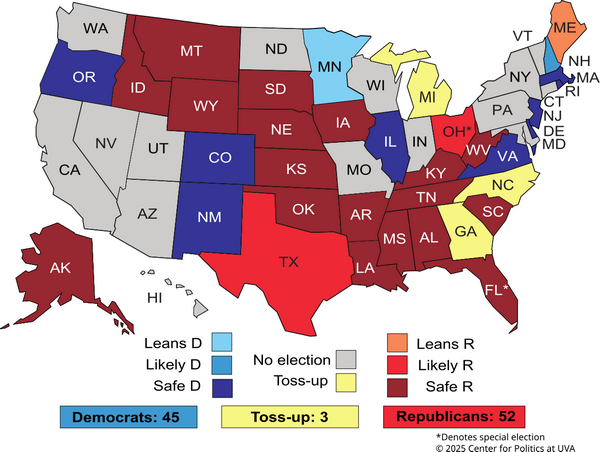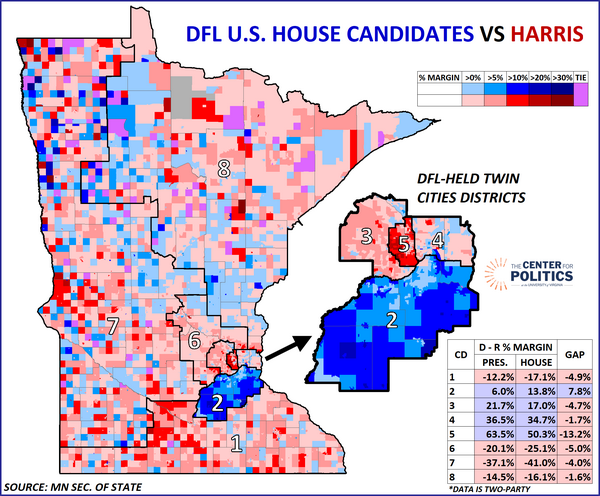KEY POINTS FROM THIS ARTICLE
— In Minnesota, Sen. Tina Smith’s retirement prompted us to move the contest for her seat from Likely Democratic to Leans Democratic.
— Lt. Gov. Peggy Flanagan (D) has already effectively jumped into the race, though other Democrats, especially from the state’s House delegation, could also join in.
— While Republicans have not won a statewide race in Minnesota since 2006, their primary is already shaping up.
— Democratic incumbents in Michigan and now Minnesota may have retired at an advantageous time for their party, but the open-seat contests may prompt some Republicans to take second looks at those races.
Table 1: Crystal Ball Senate rating change
Map 1: Crystal Ball 2026 Senate ratings

While Crystal Ball readers can usually count on getting a fresh newsletter on, at least, each Thursday morning, sometimes we’re reminded that the happenings of the political world don’t revolve around our schedule.
One such case came last Thursday: Hours after we released our initial ratings for the 2026 Senate races, Sen. Tina Smith (D-MN) announced that she’d forgo running for a second full term.
With Smith stepping aside, Minnesota will see its first open-seat Senate contest since 2006, and the first true open-seat race for this seat in the postwar era. The news prompted us to make a quick call shifting our rating from Minnesota from Likely Democratic to Leans Democratic—today, we’ll go more into the race.
Smith’s decision marked the second retirement of the 2026 Senate cycle in as many months, as Sen. Gary Peters’s (D-MI) retirement announcement came in late January. Aside from being Upper Midwest Democrats in their mid-60s, Peters and Smith’s Senate careers have actually followed a comparable electoral trajectory. Both won their first races comfortably in midterm years—Peters in 2014 and Smith, as an appointed senator running to win the seat in her own right, in 2018—but in the presidential cycle of 2020, each ran somewhat behind Joe Biden in their states. In any case, as our rating change suggests, while we still view Democrats as favorites to hold Smith’s seat, as she represents the bluer of the two states, the developing primary will be important.
Last week, Lt. Gov. Peggy Flanagan (D) did not waste much time: She filed paperwork to run for the seat within two hours of Smith bowing out of the race. Flanagan got some attention last year as it was possible she’d ascend to the state’s top job if Gov. Tim Walz (D) won the vice presidency. She would have become the nation’s first Native American woman governor if the Harris/Walz ticket won the White House.
When the presidential election did not go Democrats’ way, an awkward dynamic seemed to ensue between Minnesota’s top two officials, who until then were believed to have a good relationship. Walz is not term-limited and clearly wants to remain active in politics; however, if he went ahead with a reelection bid, he’d have risked the poor optics of keeping his demographically significant lieutenant governor from rising further—during the presidential campaign, Flanagan did not exactly keep it a secret that she’d be happy to take over. With Flanagan out of the mix for the gubernatorial race, Walz’s path to a third term would seem easier. Though Walz has not ruled out a Senate run, he has said he’d stay out of the race as long as Flanagan officially moved ahead with her campaign for the seat.
While we suspect Flanagan would be able to hold the seat in the general election, compared to the last sitting lieutenant governor who won a Senate seat, Pennsylvania’s John Fetterman (D), she is somewhat less proven. Minnesota uses a “team primary” selection system for lieutenant governors while Pennsylvania’s system is more of a “shotgun wedding.” So while Walz and Flanagan have navigated their primaries, and general elections, as a team, Fetterman at least had to win a statewide primary in his own right in 2018. Of course, Smith, who was Minnesota’s sitting lieutenant governor when she was appointed to replace former Sen. Al Franken (D) in 2018, had not faced voters on her own before running in a special election that year—but she still won by a double-digit margin comparable to what Walz took in the open gubernatorial race that year.
Though Minnesota Democrats hold all partisan statewide offices, other potential Senate candidates from their side could come from their House delegation. Electorally, that could either help or hurt Democratic chances, depending on which members enter the race. Specifically, Reps. Angie Craig (D, MN-2) and Ilhan Omar (D, MN-5) are considering the race—the former has about locked down a light blue seat while the latter typically runs behind the partisan baseline in a deep blue seat. To illustrate this, Map 2 compares the 2024 presidential results in Minnesota to its House results; Democratic House candidates outperformed Harris in blue areas and ran behind her in red.
Map 2: Presidential vs. House results in Minnesota in 2024

If Craig got into the race, she’d have a strong electability argument: Her nearly 14% margin was more than double Harris’s 6% margin in MN-2, and she was the only House Democratic candidate in the state that outperformed Harris. House Republicans would probably welcome the news of an opening in MN-2 and work for a repeat of what happened in Michigan last year: as then-Rep. Elissa Slotkin (D, MI-7), who amassed a strong electoral record in the House, moved to the Senate, Democrats lost her House seat. But MN-2 is several notches bluer than MI-7, so we’d likely still favor Democrats in an open-seat situation.
If the blue outline of MN-2 is easily visible on the map, so is MN-5’s, except that the Minneapolis-centric district is deep red. Omar performed 13 percentage points worse than Harris in her district. In fact, according to our calculations from Drew Savicki’s 2024 “Pres by CD” sheet, if Democratic candidates in every district ran that much behind Harris, they would have only won about 145 seats in the House (they won 215 in actuality, falling just a few seats short of a majority). While district-level performances have not always been predictive of success when House members run in state races, it is hard to see how an Omar nomination would be a positive development for national Democrats.
There would also be an ideological component to a primary that involved the aforementioned Democratic women: Craig’s “lane” would be closest to the center, Omar’s would be furthest to the left, and Flanagan would fall in between, if more towards the progressive side.
Minnesota Republicans have not won a partisan statewide race in nearly two decades, although they have occasionally come within a whisker of doing so. Almost immediately after the 2024 election results came in, Royce White, the GOP’s losing nominee against Sen. Amy Klobuchar (D-MN) and a former professional basketball player, announced another Senate run. Minnesota was not a key Senate race last year. Part of the reason had to do with Klobuchar’s own strength: though her 56%-40% win over White made for the smallest margin of her Senate career, she still ran 13 percentage points better than Harris did in the state. White, meanwhile, was a weak candidate: with a record of conspiracy-tinged comments, Republicans in other races downplayed their association with him. Other announced candidates in the GOP primary include retired Navy SEAL Adam Schwarze, while retired sportscaster Michele Tafoya is close to making a decision on entering the race.
According to the Star Tribune’s Sydney Kashiwagi, several possible candidates that come from more established political backgrounds are waiting to see what Rep. Pete Stauber (R, MN-8) does. Since getting to the House in 2018, Stauber has easily won reelection in a textbook Obama-to-Trump district that includes Duluth. Stauber’s interest group scores typically make him the least conservative federal-level Republican from Minnesota—for one thing, he comes from a district where organized labor has traditionally had a presence—although he can hardly be called a liberal. But all four GOP members of the Minnesota delegation hold double-digit Trump seats, so the ease of reelection could make an uphill statewide run less attractive.
Republicans’ statewide drought began in 2008, when then-Sen. Norm Coleman (R) lost his seat to the aforementioned Franken by 312 votes—Franken was seated more than six months after Election Day, following prolonged litigation. Coleman’s daughter-in-law, state Sen. Julia Coleman (no relation to the author), is considering running for Smith’s seat. In 2022, as Walz ran nearly even in Coleman’s historically Republican Carver County-based seat, she was reelected by 9 points.
So, at least until the primary fields get more settled, we’re parking Minnesota in the Leans Democratic column. If the 2026 environment ends up being defined by backlash to the Trump administration, that would obviously also bode well for Democrats’ outlook here. But if Senate Republicans can finally claim a seat in Minnesota, they’ll likely be on track to exceed the 55-seat goal that National Republican Senatorial Committee Chairman Tim Scott (R-SC) set.
Overall, having to defend Minnesota and Michigan as open seats makes the Democratic Senate map a little more challenging, and it’s possible that they’ll have to defend a third open seat in a competitive state, New Hampshire, if Sen. Jeanne Shaheen (D) retires. However, given what usually happens in midterms, it may be easier to defend these seats in a midterm year with a Republican in the White House than it would be under different circumstances.
